|
What are the recent developments in the Israel-Palestine conflict?
In July 2014 Israel again has taken military action against the former occupied territory of Gaza in retaliation for ongoing terrorist attacks. The development has made peace efforts in the region as illusive as ever.
There has been no recent progress in resolving this ongoing dispute despite renewed efforts by the United States to mediate the dispute in the Spring of 2011. The recent Israeli actions to expand settlements and occupy further areas of Jerusalem has caused some international condemnation. The principal international ally of Israel remains the United States. In June 2010, a ship with peace activists headed for Gaza with humanitarian supplies was intercepted by the Israeli navy for inspection. Nine passengers were killed by Israeli soldiers. Several dozen passengers and seven Israeli soldiers were injured. The sequence of events is disputed. Passengers say that the Israelis opened fire before boarding, while Israelis say that the firing occurred after soldiers were ambushed by passengers. Whatever version is correct, the resulting international furor has been primarily directed at Israel.
In December 2008, Israel has launched a massive attack against the formerly occupied territory of Gaza and its Hamas-led regime. Following the expiration of a cease fire agreement on December 19, Hamas resumed its rocket and mortar attacks on Israel. On December 27, Israel launched its military operation with the stated objective of defending itself from Hamas rocket fire. Since the beginning of the conflict, 13 Israelis have been killed during this conflict, including three civilians. On the Palestinian side, it is estimated that 1,314 individuals have been killed, including 700 civilians. The UN Security Council passed a resolution calling for a cease fire and Israel unilaterally ceased hostilities on January 19. Israel's actions were generally condemned internationally and even in the U.S. there was more sympathy with the Palestinian situation. In September 2009, a UN special mission, headed by Justice Richard Goldstone, produced a report accusing both Palestinian militants and Israeli Defense Forces of war crimes and possible crimes against humanity, and recommended bringing those responsible to justice. The UN Human Rights Council endorsed the report, criticizing Israel but not Hamas.
In 2006, a year of fledging progress in resolving the Israel-Palestine dispute was suddenly reversed by a flare-up of hostilities between Israel and the Hezbollah-controlled southern portion of Lebanon. The kidnapping and murder of Israeli soldiers escalated into all out warfare which at this writing has been halted by an internationally-negotiated ceasefire.
This conflict has less to do with the present Palestinian situation in Gaza and the West Bank but is rather illustrative of the problems Israel faces with its northern neighbors many of whom have Palestinian origins. Following its expulsion from Jordan in 1982, much of the PLO moved to southern Lebanon where they established de facto control of the region. Their presence in that region contributed to a civil war which plagued Lebanon for over a decade during which time Israeli forces invaded Lebanon on multiple occasions in response to PLO attacks. In 1985, Israel withdrew its forces from much of Lebanon but maintained a security strip in the south. This occupation lasted until 2000. Since then Hezbollah, the successor to the PLO in the region, put considerable effort into fortifying the former security zone and establishing new firing positions. Hezbollah has been supported in these efforts by Syria and Iran. There have been several skirmishes leading to the current full-out conflict.
In December 2005, Israeli Prime Minister Ariel Sharon suffered a massive stroke and has been in a coma since. The Israeli leadership picture is unclear in his absence nor is it clear whether the development will improve the relationship with the Palestinian authority. In the meantime, elections were held in Palestine in January 2006 and the militant organization Hamas scored a resounding victory. Observers credited the defeat of the moderate Fateh party of Mahmud Abbas to poorly run campaign strategies and to voter dismay over the long history of corruption within Palestinian Authority leadership. Like Arab extremist organizations elsewhere, Hamas advocates a governmental system based on Islamic religious principles. The degree to which the Hamas victory will impede progress toward a peaceful resolution of the Israel/Palestine dispute is unclear. A long term Islamic Palestinian government would not seem to bode well for future cooperative endeavors between the Palestinian Authority and Israel. Such cooperation will be necessary for economic progress in the region.
In September 2005, Israel completed a unilateral withdrawal from the Gaza strip ending its 38 year occupation of the region. The Israeli settlements were dismantled. The withdrawal and Palestinian assumption of power has gone relatively smoothly.
In November 2004 Yasser Arafat died from a sudden mysterious ailment. In January 2005 an election was conducted and the moderate Mahmud Abbas was elected. Abbas had briefly assumed the presidency of the Palestinian Authority in 2003 before disagreements with Arafat caused him to resign. Since the election here have been significant developments in the path toward a peaceful resolution of the problem. For the first time in four years, Israeli and Palestinian officials met to mutually discuss peace possibilities. Sporadic violence from Palestinian extremists does continue however.
The Gaza pullout has coincided with a significant reduction in hostilities. The Palestinian "intifada" began in September 2000 and has consisted of periodic terrorist incidents and subsequent Israeli reprisals. These incidents resulted in the deaths of over 6000 persons; the majority of them Palestinians.  (Click to see chart) A major reprisal occurred in March 2004 with the Israeli assassination of Hamas leader Ahmed Yassin. The U.S. role as major broker in the peace effort has been significantly hampered by ill will throughout the Arab world in response to the Iraq invasion and occupation and by the Bush Administration's recent indication that it would support Israel's claim to certain West Bank settlements. This is a fundamental shift in U.S. policy regarding the dispute. (Click to see chart) A major reprisal occurred in March 2004 with the Israeli assassination of Hamas leader Ahmed Yassin. The U.S. role as major broker in the peace effort has been significantly hampered by ill will throughout the Arab world in response to the Iraq invasion and occupation and by the Bush Administration's recent indication that it would support Israel's claim to certain West Bank settlements. This is a fundamental shift in U.S. policy regarding the dispute.
In 2003, a "road map" peace plan developed by the U.S, Russia, the European Union and the United Nations was presented to Israel and the Palestinian Authority. The plan calls for the immediate cessation of hostilities and Israeli withdrawal from areas that it has occupied since September 2000 as a condition for further negotiations regarding the nature of a Palestinian state. In response to this initiative, there was some conciliatory rhetoric from both sides and actual peace negotiations but there has been little bilateral progress.
Against significant opposition from within his party and from the settlers, Ariel Sharon accomplished a unilateral removal of the Israeli settlements in Gaza, although he continues to take a very hard line on other issues, including the West Bank settlements. Under the Gaza withdrawal plan, full administration of the Gaza strip was turned over to the Palestinian Authority which had previously controlled 80% of the area. Israel would maintain control of Gaza's borders, coastline and airspace. While welcoming any withdrawal by Israel from lands it has occupied since the 1967 war, the Palestinians have reacted to Sharon's initiative with suspicion and insist on a return to the "roadmap", which calls for a negotiated step-by-step plan.
Another controversial development has been Israel's unilateral decision to construct a "security barrier" in the West Bank.  (Click to see map) Construction on this prison-type fence began in June 2002 and its planned length will extend approximately 440 miles. It is only partially constructed. The actual and proposed route of the wall does significantly separate areas dominated by each population and thus offers a "de facto" basis for a negotiated settlement. But Israel insists that the barrier does not constitute a proposed border but rather has been erected for security purposes only - to prevent suicide bombers from entering Israeli occupied areas. The construction of the barrier is controversial among Israelis as well as Palestinians. Right wing Israelis are concerned that the wall isolates Israeli West Bank settlements and is a signal that they will eventually not be supported. They are pressuring the government to construct additional walls which encircle such settlements. Palestinians object that the wall is another unilateral undertaking by the Israeli government in occupied territory and that it is a violation of international law. In an advisory opinion, the International Court of Justice ruled against the barrier in July 2004, and stated that it should be dismantled. The Israel Supreme Court rejected this opinion in September 2005. The U.S. would certainly block any attempt by the Security Council to implement the opinion. (Click to see map) Construction on this prison-type fence began in June 2002 and its planned length will extend approximately 440 miles. It is only partially constructed. The actual and proposed route of the wall does significantly separate areas dominated by each population and thus offers a "de facto" basis for a negotiated settlement. But Israel insists that the barrier does not constitute a proposed border but rather has been erected for security purposes only - to prevent suicide bombers from entering Israeli occupied areas. The construction of the barrier is controversial among Israelis as well as Palestinians. Right wing Israelis are concerned that the wall isolates Israeli West Bank settlements and is a signal that they will eventually not be supported. They are pressuring the government to construct additional walls which encircle such settlements. Palestinians object that the wall is another unilateral undertaking by the Israeli government in occupied territory and that it is a violation of international law. In an advisory opinion, the International Court of Justice ruled against the barrier in July 2004, and stated that it should be dismantled. The Israel Supreme Court rejected this opinion in September 2005. The U.S. would certainly block any attempt by the Security Council to implement the opinion.
Are the issues in the Israel-Palestine conflict impossible to resolve?
No, the two major issues between the two sides have been resolved for almost a decade. These are:
- The legitimacy of Israel. During much of the Israel-Mideast conflict this has been the issue and it has been conclusively resolved. While some fundamentalist Arab rhetoric continues to challenge Israel's right to exist, most Arab nations and Palestinians now accept that Israel has secured its status and is entitled to the pre-1967 borders. More importantly, the international community and the United States are committed to support Israel's right to exist.
- The right of Palestinians to self-rule. The early rounds of peace agreements have achieved this limited degree of recognition from Israel and self-rule does exist in certain areas of the West Bank as a result of prior peace negotiations.
What major issues remain?
- The status of Jerusalem.
Both sides made significant concessions on this issue at Camp David in 1999. The Palestinians agreed that the Jewish Quarter and the Western Wall, which were under Arab control until the 1967 war, would fall under Israeli sovereignty. The Israelis offered the Palestinians control of some East Jerusalem neighborhoods. At center stage was one issue: the political fate of the Harem al-Sharif/Temple Mount area of Jerusalem, which is holy both to Muslims and Jews. The Israelis ultimately proposed that the Palestinian leader would be called "custodian" of Haram al-Sharif and would be able to fly his own flag on the mosques- but they would remain under Israeli sovereignty. This proposal was rejected by the Palestinians. President Clinton ultimately concluded that the Palestinians were most responsible for failing to achieve an agreement because they were not flexible on this issue.
- The future of Israeli settlements.
At Camp David in 1999, Barak agreed to eventually withdraw from 90% of the settlements. Arafat agreed that Jewish settlers on the West Bank could remain in settlement blocks in portions of the West Bank that would come under Israeli sovereignty as long as the Palestinians were compensated with new territories, probably near Gaza. However, the Palestinians maintain that the Israeli proposal would permit Israel to annex almost 9% of the Occupied Palestinian Territories in exchange for only 1% of Israel's own territory. The Palestinians observed that the proposal would create a Palestine of four separate cantons entirely surrounded by Israel. The Palestinians also objected to portions of the Israeli proposal which denied them control over their own borders, airspace and water resources.
- Rights of Palestinian Refugees
About 500,000 to 780,000 Palestinians were displaced during the 1948 Israeli War of independence, either because they fled Palestine or because they were forced out by the Israelis. UN General Assembly Resolution 194, issued in December 1948, stated that refugees wishing to return to the territory of Israel and willing to live at peace with their neighbors should have the right to do so. The resolution was never implemented. In the 50 years that followed, the refugee population has grown to about 4 million (estimates range from 3.7 million to 4.6 million), many living in camps in Lebanon, Syria, Jordan, the Gaza Strip and West Bank, in the most primitive conditions.
At Camp David, Yasser Arafat agreed to separate the issue of the "right" of the Palestinian refugees to return to their homes from the actual settlement of claims to that right. The Israelis agreed to consider the return of refugees under humanitarian grounds in the form of family reunions and agreed to the resettlement of an unspecified number of additional refugees. The resolution of this issue would also include financial support and assistance from the United States and other countries. But no progress was made on a detailed compromise based on these concessions because of the lack of progress on the other issues.
The Palestinian groups involved in the conflict are the PLO, Hamas, and Hezbollah. How do these groups differ?
- The Palestinian Liberation Organization (PLO) remains the popular name for the Palestinian Authority which is under the leadership of Yasser Arafat. The PA is an autonomous government that was established by a series of early 1990s Israeli-Palestinian peace pacts to rule over most Palestinians in the West Bank and Gaza and probably become the basis for a full-blown Palestinian state later in the peace process. The PA lacks many powers associated with a state such as complete control of its territory but is responsible for providing such varied government services as education, criminal justice, health care, and trash collection for some 3 million Palestinians. It rules virtually all of poverty-stricken Gaza and has shared or total control of about 40 percent of the West Bank; the rest of the West Bank, including more than 100 Israeli settlements, is under Israeli control. The regime is dominated by Arafat; opposition groups called for a boycott of the PA's 1996 elections, which were swept by Arafat allies. The PA has been criticized by human rights groups for authoritarian practices.
- Hamas
(Islamic Resistance Movement) is a radical Islamic organization which became active in the early stages of the Intifada (the mainstream Palestinian resistance movement begun in 1987), operating primarily in the Gaza Strip but also in the West Bank. The Hamas has played a major role in violent fundamentalist subversion and radical terrorist operations against both Israelis and Arabs. Hamas is committed to a "holy war" for the liberation of Palestine and the establishment of an Islamic Palestine "from the Mediterranean Sea to the Jordan River". By its participation in street violence and murder, it boosted its appeal in the eyes of the Palestinians, further enhancing its growth potential and enabling it to play a central role in the Intifada. As a result of its subversive and terrorist activity, Hamas was outlawed in September 1989. After the Gulf War, Hamas has become the leading perpetrator of terrorist activity throughout the territories as well as inside Israel.
Hamas and the PA sometimes cooperate, sometimes compete, and sometimes clash. Hamas has cut deals with the PA, but it accuses Arafat's regime of being corrupt and of selling out to Israel and America by participating in the peace process. U.S. officials have told Arafat that Hamas is as much of a threat to him as it is to Israel. The Israeli government believes that the level of cooperation between the PA and Hamas has increased during the past year and there is some evidence to support this claim. Yet the timing of terrorist activities initiated by Hamas continue to frustrate peace efforts which the PA at least ostensibly supports.
- Hezbollah
is a Lebanese group of Shiite militants that has evolved into a major force in Lebanon's society and politics. It opposes the West, seeks to create a Muslim fundamentalist state modeled on Iran, and is a bitter foe of Israel. The group's name means "party of God". According to the State Department, the group receives substantial amounts of financial, training, weapons, explosives, political, diplomatic, and organizational aid from Iran and Syria. Hezbollah is also an important player in Lebanon's politics, a key vehicle of Lebanese Shiite empowerment, and a major provider of social services to thousands of Lebanese Shiites. The group has been responsible for a series of kidnappings of Westerners, including several Americans, in the 1980s; the suicide truck bombings that killed more than 200 U.S. Marines at their barracks in Beirut, Lebanon, in 1983; the 1985 hijacking of TWA flight 847, which featured the famous footage of the plane's pilot leaning out of the cockpit with a gun to his head;
and two major 1990s attacks on Jewish targets in Argentina-the 1992 bombing of the Israeli embassy (killing 29) and the 1994 bombing of a Jewish community center (killing 95).
The situation in Israel involves the West Bank, the Gaza Strip, and the Golan Heights. Where are these areas located?
All of these areas came under Israel's control as the result of the 1967 Six Day War.
How did the Israeli - Palestinian conflict originate?
The conflict is the result of a unique history of immigration and emigration of two groups with very distinct religious and cultural traditions which occurred during the past century. A brief history:
- 1516 - 1917 Ottoman Empire After the collapse of the Roman Empire, the area known as Palestine was primarily ruled by a succession of Muslim rulers. The Turkish Ottoman Empire
 was the last of these dynasties. At the end of the 19th Century, Jews began to immigrate to Palestine in response to a Zionist campaign launched by influential Jewish Europeans. was the last of these dynasties. At the end of the 19th Century, Jews began to immigrate to Palestine in response to a Zionist campaign launched by influential Jewish Europeans.
- 1917 - 1948 British Protectorate Subsequent to World War I, the area (including much of Jordan) came under British Administration.
 The Zionist concept was encouraged by Britain and there was considerable Jewish immigration into the area. The immigration accelerated during the Nazi regimes in Europe and many Jews literally saved their lives by deciding to relocate. Conflicts between the new settlers and the Arabian native inhabitants resulted from this immigration. These conflicts had both economic and religious aspects. The Jewish immigration and land purchases displaced many natives and the problem was compounded because the two religions share historical places of worship. A British commission investigating the problem concluded that the only realistic solution would be to partition the area into Arab and Jewish sectors. The Zionist concept was encouraged by Britain and there was considerable Jewish immigration into the area. The immigration accelerated during the Nazi regimes in Europe and many Jews literally saved their lives by deciding to relocate. Conflicts between the new settlers and the Arabian native inhabitants resulted from this immigration. These conflicts had both economic and religious aspects. The Jewish immigration and land purchases displaced many natives and the problem was compounded because the two religions share historical places of worship. A British commission investigating the problem concluded that the only realistic solution would be to partition the area into Arab and Jewish sectors.
- 1948 U.N. Partition The future of Palestine subsequent to World War II came under the jurisdiction of the United Nations. In a historic vote, the General Assembly voted to accept the concept of partition of Palestine into Arab and Jewish sectors thus creating the Jewish country of Israel .
 The plan also called for Jerusalem to be an international zone free of either Arab or Jewish rule. The plan was vehemently opposed by Arabian countries and immediately after the vote a war developed between Israel and the neighboring Arabian countries of Egypt, Jordan, Lebanon, Syria and Iraq. The plan also called for Jerusalem to be an international zone free of either Arab or Jewish rule. The plan was vehemently opposed by Arabian countries and immediately after the vote a war developed between Israel and the neighboring Arabian countries of Egypt, Jordan, Lebanon, Syria and Iraq.
- 1949 Armistice to 1967 At the conclusion of the Israeli-Arabian war, Israel's boundaries considerably extended beyond the area identified in the U.N. Partition.
 The area gained included much of the Gaza territory and eastward into Jordan as far as the Jerusalem area. Jerusalem itself was divided into areas under Jewish and Jordanian control. In 1950 Israel designated Jerusalem as its capital but this designation has not received recognition by the international community and most countries maintain their embassies in Tel Aviv. Subsequent to this war, many Palestinian Arabs emigrated from the area controlled by Israel to the West Bank, Gaza, Jordan, Syria, Lebanon, and other Arabian countries. This period is characterized by the development of Israel into a modern nation assisted by massive immigration. It was also characterized by continuing hostility between Jewish residents and the Arab Palestinian minorities who remained in Israel and those who were outside of the Israeli borders on the West Bank, Gaza, Lebanon and Egypt. The surrounding Arab countries continued to refuse to recognize the existence of Israel's sovereignty. The situation erupted into a brief war in 1955 which did not result in a change of boundaries. The area gained included much of the Gaza territory and eastward into Jordan as far as the Jerusalem area. Jerusalem itself was divided into areas under Jewish and Jordanian control. In 1950 Israel designated Jerusalem as its capital but this designation has not received recognition by the international community and most countries maintain their embassies in Tel Aviv. Subsequent to this war, many Palestinian Arabs emigrated from the area controlled by Israel to the West Bank, Gaza, Jordan, Syria, Lebanon, and other Arabian countries. This period is characterized by the development of Israel into a modern nation assisted by massive immigration. It was also characterized by continuing hostility between Jewish residents and the Arab Palestinian minorities who remained in Israel and those who were outside of the Israeli borders on the West Bank, Gaza, Lebanon and Egypt. The surrounding Arab countries continued to refuse to recognize the existence of Israel's sovereignty. The situation erupted into a brief war in 1955 which did not result in a change of boundaries.
- 1967 "Six Day War" to 1979 Two decades of Mideast tensions resulted in a major war in 1967. The actual war began with a coordinated Israeli attack on Egypt but the events immediately leading to the attack were Egypt's removal of a U.N. Emergency Force at the border and a blockade of Israeli shipping through the Tiran straits
 leading to the Red Sea. Jordan joined the war with an attack on Israel which was quickly repulsed. The result of this war was a total victory for Israel. It has also resulted in Israeli control of the West Bank, the Gaza Strip, the entire Sinai Peninsula and the Golan Heights. leading to the Red Sea. Jordan joined the war with an attack on Israel which was quickly repulsed. The result of this war was a total victory for Israel. It has also resulted in Israeli control of the West Bank, the Gaza Strip, the entire Sinai Peninsula and the Golan Heights.  The war had a significant implication beyond the Middle East because it resulted in the closure of the Suez canal and it remained closed until 1975. Israel's control of areas primarily populated by Palestinians has been the major source of unrest and conflict since this war. In order to facilitate control, Israel began sponsoring controversial settlements in these occupied areas. The war had a significant implication beyond the Middle East because it resulted in the closure of the Suez canal and it remained closed until 1975. Israel's control of areas primarily populated by Palestinians has been the major source of unrest and conflict since this war. In order to facilitate control, Israel began sponsoring controversial settlements in these occupied areas.
- 1979 Peace Treaty with Egypt to 1993 A major breakthrough for peace in the Middle East began in 1977 and culminated in a treaty facilitated by American President Jimmy Carter in 1979. Under the terms of this treaty, Egypt recognized Israel and permitted Israel to use the Suez Canal. Israel returned control of Sinai to Egypt
 and agreed to negotiate the future of the Gaza Strip for possible Palestinian rule. Unfortunately, these developments did little to affect increasing tensions between Israelis and Palestinians. Moreover, due to a higher birth rate and declining death rate, the Palestinian population began to grow at a greater rate than the Jewish population. In 1982, Israeli forces attacked areas in Southern Lebanon and Beirut which had been harboring Palestinian terrorists. In 1987, an Intifada uprising among Palestinians in the West Bank and Gaza began which involved massive civil disobedience. In 1989, the Palestinian Liberation Organization (PLO) recognized Israel's right to exist for the first time. This eventually led to peace talks and an agreement in 1993. and agreed to negotiate the future of the Gaza Strip for possible Palestinian rule. Unfortunately, these developments did little to affect increasing tensions between Israelis and Palestinians. Moreover, due to a higher birth rate and declining death rate, the Palestinian population began to grow at a greater rate than the Jewish population. In 1982, Israeli forces attacked areas in Southern Lebanon and Beirut which had been harboring Palestinian terrorists. In 1987, an Intifada uprising among Palestinians in the West Bank and Gaza began which involved massive civil disobedience. In 1989, the Palestinian Liberation Organization (PLO) recognized Israel's right to exist for the first time. This eventually led to peace talks and an agreement in 1993.
- 1993 Oslo Peace Agreement to Present
As the result of highly secret negotiations, an agreement was signed in 1993 which set forth a timetable for Palestinian rule in the Gaza Strip and the West Bank. Under the terms of the first agreement, Palestinian rule was to be provided to the Gaza Strip and Jericho and this was accomplished in 1994. Under a second agreement negotiated in 1995, Israeli forces were scheduled to be removed from six Arab cities and 400 villages in the West Bank by early 1996, after which elections would be held for a 82-member Palestinian council, which would possess legislative and executive power in the West Bank and Gaza.
 The remaining issues which have not been resolved concern the remainder of the West Bank, particularly Jerusalem, and whether Israeli settlers can remain in formerly occupied territories under Palestinian control. In 1994, Israel also concluded a peace treaty with Jordan. The remaining issues which have not been resolved concern the remainder of the West Bank, particularly Jerusalem, and whether Israeli settlers can remain in formerly occupied territories under Palestinian control. In 1994, Israel also concluded a peace treaty with Jordan.
The peace momentum was broken with the assassination of Israel Prime Minister Rabin by an Israeli right wing extremist in November 1995. During the remainder of the decade, progress toward a final peace has been elusive.
One of the weaknesses of the 1990s Oslo peace process was that it deliberately left the most difficult issues - the status of Jerusalem, refugees and borders - until last, in the belief that this would make them easier to resolve.
These issues were finally discussed when the former US President Bill Clinton made an all-out attempt to bring then Prime Minister Ehud Barak and the Palestinian leader Yasser Arafat together at Camp David in Maryland, Virginia.
An agreement was in sight, but talks broke down over failure to agree on the future of Jerusalem and - to a lesser extent - the fate of Palestinian refugees. Israeli leaders believed they had been generous to the Palestinians, while Palestinian negotiators rejected the proposals as inadequate. The two sides came even closer to agreement when they met in Taba, Egypt in January 2001. But this, too, ended in failure. There has been very little progress on the diplomatic front since Mr. Sharon took office more than a year ago. He has accused his predecessor of offering the Palestinians unacceptable concessions at Camp David and that all Israel got in return was violence. One of the biggest obstacles to final status agreement is the issue of Jewish settlements, and Mr Sharon has long been seen as a champion of the settlers' cause. The Palestinian Authority currently controls most of Gaza but less than 40% of the West Bank, in non-contiguous chunks that are dotted with Israeli settlements. The Palestinians believe there can only be a purely Palestinian state if the settlements are dismantled.
This failure led to a second Intifada with accompanying violence which began in the fall of 2000. There have been frequent acts of terrorism and Israeli reprisals. Ultimately Israel's decision to end occupation of Gaza helped end the Intifada but the subsequent military action undertaken by Israel against Gaza in 2008 renewed the high level of tension in the area which remains.
What concepts form the basis of Israeli and Arab positions on this conflict?
- Israeli position The overall Israeli position is based in some part on the Zionist philosophy that led to the Jewish settlement in Israel and mainly on its reaction to the fierce opposition of Arabs to Israel's existence. Through the peace initiatives during the past three decades there has been gradual recognition among the Arab countries and the Palestinians of the legitimacy of Israel. But the long history of Arab opposition has caused many Israelis to believe that only force, military defense and control are essential to internal security. This attitude, which is reflected in the recent election of the "hard line" Prime Minister Ariel Sharon, makes the compromise essential to a peace effort very difficult. Other Israelis have come to realize that the decades of occupation in the Arab areas of the West Bank and Gaza has been counterproductive. Instead of providing security, they realize this policy has led to an escalation of Palestinian resistance and international approbation. Opinion polls reflect the divide among Israelis on this issue.

- Arab position The present Arabian position surrounds the demand of Palestinians for an Arab state which was contemplated by the 1948 United Nations partition. Historically, Israel's Arab neighbors have opposed its very existence but the reality of Israel as a viable military and economic power in the area with a large population base is now generally recognized. The focus during the past three decades has been support for Palestinian independence. Palestinian public opinion is also divided on the possibility of accomplishing this through a settlement.

What has been the United States position on this conflict?
The United States has exercised considerable diplomatic efforts over the past three decades in promoting a peaceful solution to the Israeli/Arab conflict. The U.S. is generally regarded with distrust by the Arab world because of its close ties to Israel but it is in a position to be persuasive with Israel when there have been difficulties in the negotiations. Present U.S. policy is consistent with the principles set forth in the 1978 Camp David Accords in that the status of the Gaza Strip and the West Bank is to remain unresolved until there is a final agreement between interested parties. The U.S. also recognizes that Jerusalem has a special status and the resolution of issues pertaining to Gaza and the West Bank might be different that those pertaining to Jerusalem.
What has the United Nations done regarding this problem?
In 1974, the General Assembly adopted a resolution recognizing the right of Palestine Arabs, including those in Israel, to nationhood. A second resolution gave observer status to the Palestine Liberation Organization (PLO), a group approved by Arab countries to represent the Palestinians. This international designation of the PLO as an official representative for Palestinian interests was an important step in the peace process. The United Nations Security Council has consistently opposed Israel's practice of establishing settlements in occupied territories and its policy to settle East Jerusalem and to designate Jerusalem as its capital.
Israel Palestine Links
Google Directory - Israel Palestine Conflict (review subcategories)
Wikipedia - Israel Palestine Conflict
Wikipedia - History of Israel Palestine Conflict
Wikipedia - Israel Arab Conflict
Wikipedia - First_Intifada
Wikipedia - Second_Intifada
Wikipedia - Six-Day_War
Wikipedia - Gaza_War
Council of Foreign Relations Crisis Guide: Israel-Palestinian Conflict
BBC In Depth Coverage of Israel-Palestine Conflict
Guardian - Special Report Israel and Middle East
Middle East Research and Information Project
(an excellent neutral site for background and detailed information)
News: Israel, Palestine, Middle East, & Terrorism
(This site, maintained by Charles Lipson of the University of Chicago, provides the latest news in this subject area from a variety of sources)
National Public Radio: The Mideast: A Century of Conflict
(Somewhat similar to this summary, this site provides excellent historical background information on the conflict.)
Palestinian Negotiating Team Camp David Peace Proposal of July, 2000: Frequently Asked Questions
United Nations Site Pertaining to Palestinian Conflict
IPRCI Think Tank
(A joint Israeli/Palestinian peace project headquartered in Jerusalem)
Oslo Papers
(A summary of the Conflict from the Arab perspective)
Palestine History.Com
Americans For Peace Now
Council of Foreign Relations Crisis Guide: Israeli-Palestinian Conflict
Council of Foreign Relations: Hezbollah
Council of Foreign Relations: Hamas
|
Charts
(click to enlarge)
Palestinian and Israeli Deaths in Second Intifada 2000-2008

Israel-West Bank Security Barrier Map
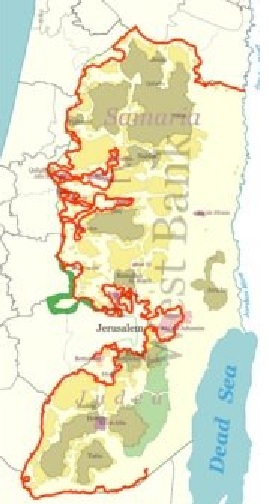
West Bank Map
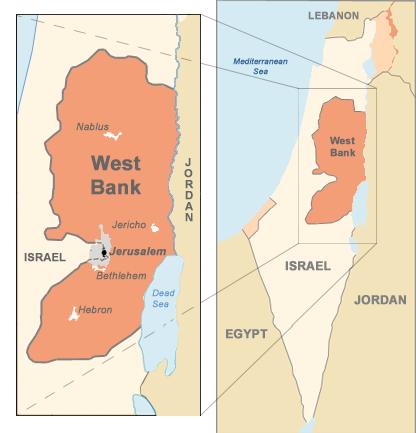
Status of Jerusalem
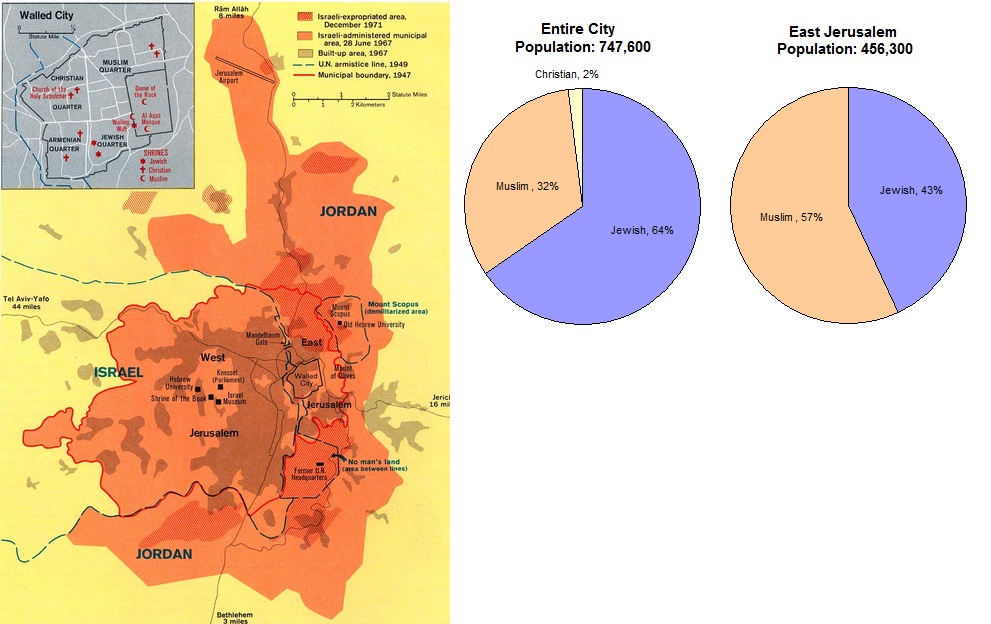
Map of Gaza
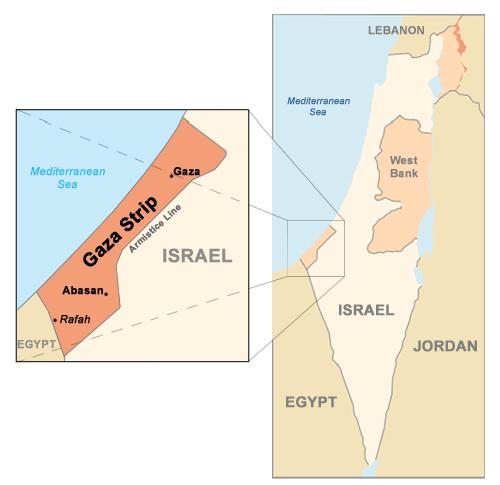
Map of Golan Heights
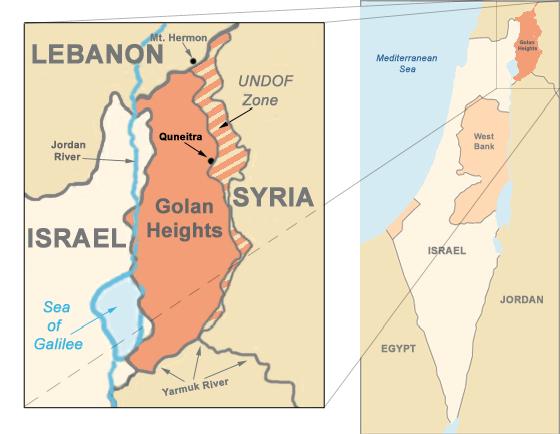
Palestine at End of Ottoman Empire
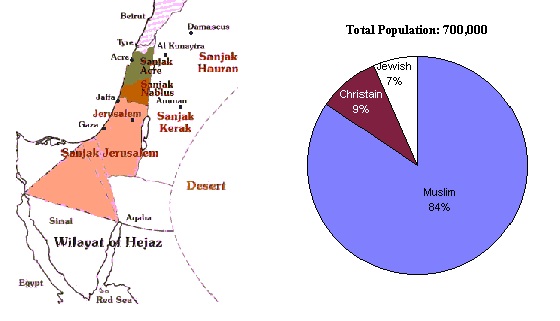
Palestine Under British Mandate 1917-1947
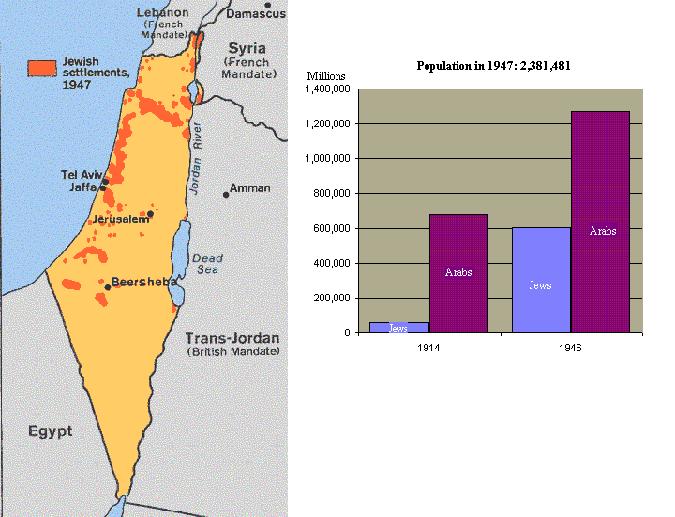
Map of U.N. Partition 1948
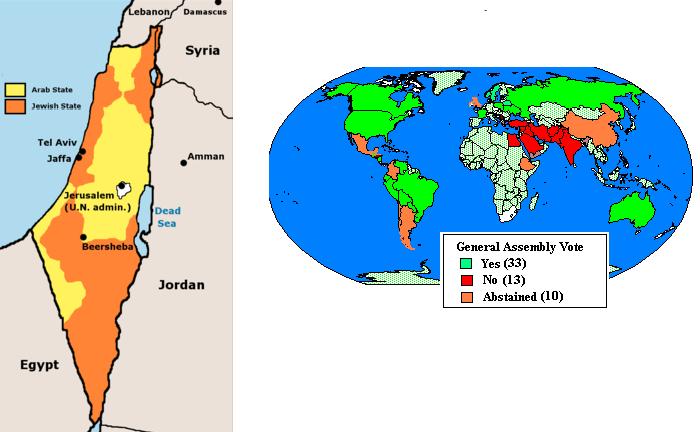
Map of Israel/Palestine 1949-1967
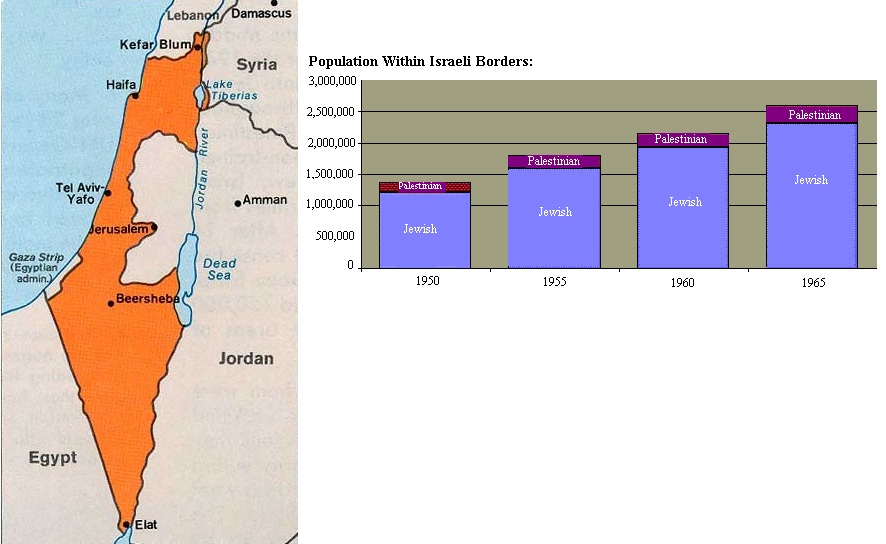
Straits of Tiran
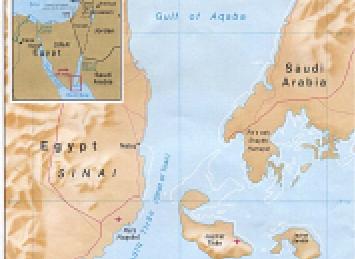
Map of Israel/Palestine From 1967 to 1979 Peace Treaty
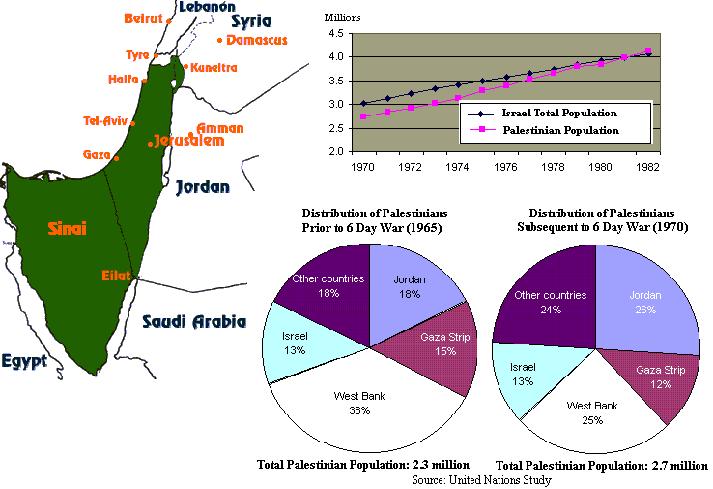
Israel/Palestine After 1979 Peace Treaty
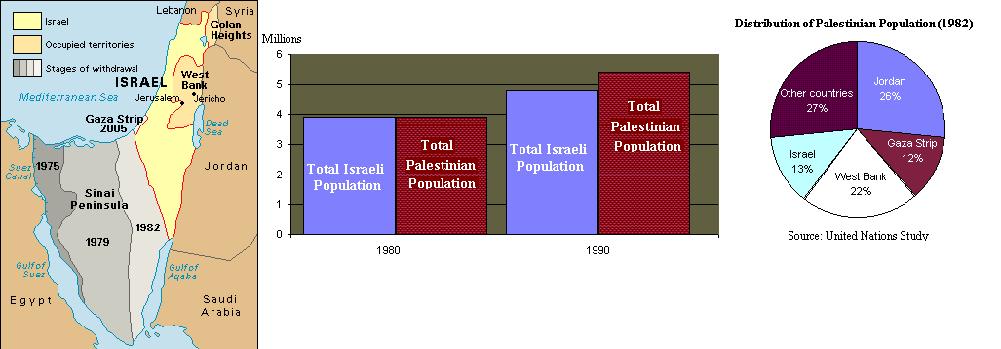
Current Situation in Israel/Palestine
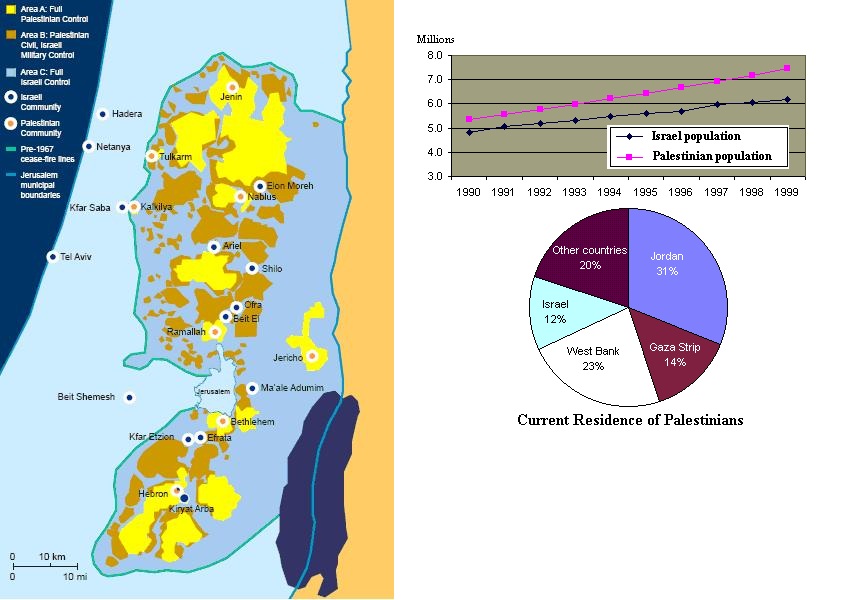
Israeli Public Opinion on Settling Dispute
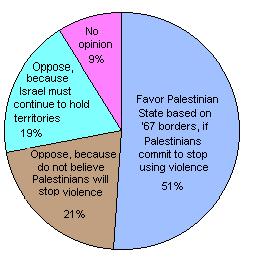
Palestinian Public Opinion on Settling Dispute
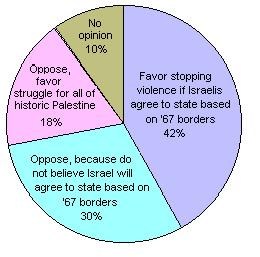
|

